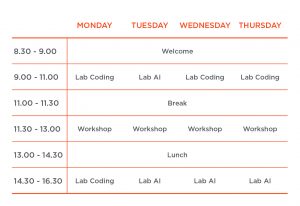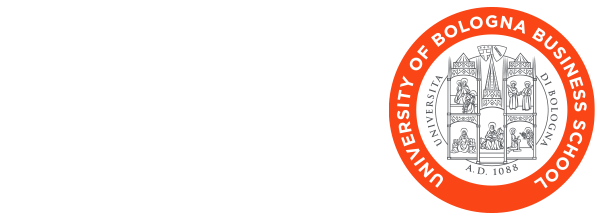
The week is designed for young people between 8 to 12, in Italian, and will take place at Villa Guastavillani, Via degli Scalini 18, for a total of 22 hours of activities (8 hours Lab Coding, 8 hours Lab AI, 6 hours Workshop on computer games, cryptography, and robotics) divided as follows:

The full program:
MONDAY 11 SEPTEMBER 2023
Starting at 9 am: ‘My first programme with Scratch: the Scratch community’.
Coding workshop with Michael Lodi. Classroom tutor: Simone Martini.
At 11:00 am: Snack break.
Starting at 11:30 am: “Robots that dance, robots that play: artificial intelligence and creativity”.
Workshop on educational robotics with Allegra De Filippo.
Students will be led, through an interactive presentation, to discover some basic ideas of artificial intelligence and robotics, trying to answer questions such as: How is it possible to interact with a robot? When can a robot be defined as intelligent? How many and what things is a humanoid robot capable of doing? Through examples and interactive simulations, students will discover how a robot is able to interact with humans, solve games such as “Guess who?”, play football, and create and perform dance choreographies. At the end of the workshop, students will discover not only the potential but also what robots cannot do.
At 13:00 pm: Lunch break.
Starting at 14:30 pm: “About me: bringing my name and passions to life with Scratch”.
Coding workshop with Michael Lodi. Classroom tutor: Simone Martini.
Closing of the day at approximately 16:30 pm
TUESDAY 12 SEPTEMBER 2023
Starting at 9:00 am: “Let’s learn to learn!”.
We explore what we can do (and not do) with artificial intelligence. We will work with Google’s teachablemachine and create a simple machine-learning model for recognizing body movements.
Artificial intelligence workshop with Stefano Zingaro. Classroom tutor: Andrea Zanellati.
At 11:00 am: Snack break.
Starting at 11:30 am: “All detectives with logic programming”.
Workshop on automatic reasoning with Stefano Forti from the University of Pisa.
Buddy has invited some classmates to his birthday party. Some play hide and seek, some swim in the pool, some pop balloons, some read in the background. But when it’s time to blow out the candles… there are only a few crumbs left of the cake! Let’s solve this mystery together with Buddy, with the help of logic programming. It will take the flair of a real detective and a dash of artificial intelligence to find out who ate the cake!
At 1 pm: Lunch break.
Starting at 14:30 pm: “Intelligent even without a computer!
I recognize the difference between two objects. We explore some machine learning algorithms with an unplugged activity.
Artificial intelligence workshop with Andrea Zanellati. Classroom tutor Maurizio Gabbrielli.
Closing of the day at approximately 16:30 pm
WEDNESDAY 13 SEPTEMBER 2023
Starting at 9 am: ‘Geometry and Art: drawing with Scratch, I learn to repeat and generalize instructions’.
Coding workshop with Michael Lodi. Classroom tutor: Simone Martini.
At 11:00 am: Snack break.
From 11:30 am: “Computer science (is), not magic”. Workshop with Micheal Lodi
Students will be led through an interactive presentation to discover some of the magic of computing: How is it possible to represent numbers, letters, images, and any other information using simple switches? How do computers search through billions of pieces of information so quickly? How do computers correct errors (e.g. in a ruined QR code)?
…and also things that computers, surprisingly, cannot do.
At 13:00 pm: Lunch break.
Starting at 14:30 pm: “Shot the bug!”. We teach the computer to play (and win) an arcade game.
We will work with IBM’s machinelearningforkids Artificial intelligence workshop with Stefano Zingaro. Classroom tutor: Andrea Zanellati.
Closing of the day at approximately 16:30 pm
THURSDAY 14 SEPTEMBER 2023
Starting at 9 am: ‘Video games and webcams: I make my program interact with the outside world’.
Coding workshop with Michael Lodi. Classroom tutor: Simone Martini.
At 11:00 am: Snack break.
From 11:30 am: “From Caesar to Whatsapp”. Cryptography workshop with Michael Lodi.
Students will play at encrypting and decrypting messages with different cryptographic systems, using a block language similar to Scratch but specially designed for cryptography. The students will also discover why Caesar’s cryptography is too weak for today’s computers, and will instead discover how it is possible to exchange messages (but also payments, and many other important pieces of information) without the need to meet, thanks to simple but ingenious mathematical properties… In this workshop, however, the mathematical formulas will become colored pencils, and the students will, as if by magic, be able to choose a shared secret color without ever speaking to each other in private.
At 13:00 pm: Lunch break.
Starting at 14:30 pm: “I recognized you!”. I recognize a face in the webcam image and turn it into a cartoon.
We will work with IBM’s machinelearningforkids. Artificial intelligence workshop with Stefano Zingaro. Classroom tutor: Andrea Zanellati.
Closing of the day at approximately 16:30 pm
Workshop: Computer science is not magic
Students will be led through an interactive presentation to discover some of the magic of computer science:
- how through switches it is possible to represent numbers, letters, images, and any other information
- how computers can very quickly search through billions of pieces of information
- how computers correct errors (for example, in a spoiled QR code)
- …but also things that computers, surprisingly, can’t do
Workshop: From Cesar to Whatsapp
Students will play at encrypting and decrypting messages with different cryptographic systems, through a block language similar to Scratch but specifically designed for cryptography.
Kids will also discover why Caesar’s cryptography is too weak for today’s computers, and will instead discover how it is possible to exchange messages (but also payments, and lots of other important information) without needing to meet, thanks to simple but ingenious mathematical properties… In this workshop, however, mathematical formulas will become colored temperaments, and the students, as if by magic, will be able to choose a shared secret color without ever talking to each other in private.
